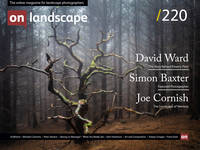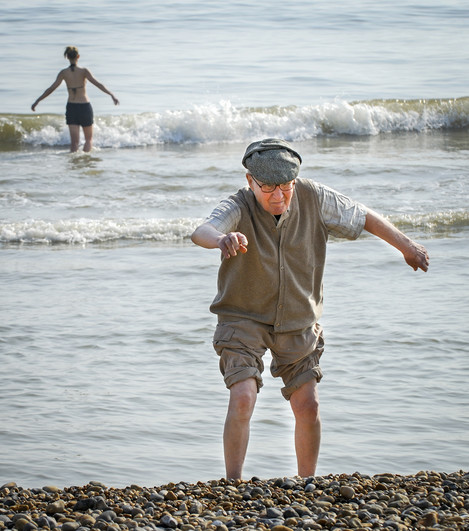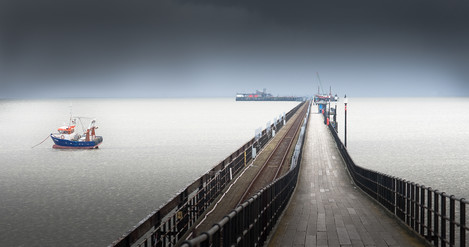Is it beauty or message or both?

Peter Stevens
Peter has been interested in landscape photography for many years but this became a passion with the arrival of digital. After Peter retired from work, and with more time on his hands, he joined the local Photographic Society and also took a degree in Photography, which was definitely a ‘curate’s egg’ experience. He enjoys photographing in the UK and also further afield. Peter’s images can be seen at local art fairs and occasionally in national and international exhibitions. Peter is a recent Chairman of the Harpenden Photographic Society and also a Fellow of the Royal Photographic Society.
In this article, Peter tries to understand what it is we are trying to communicate in our photographs.
My Problem
Let me start with an anecdote. I was visiting a local art and craft fair a few years back, held in a nearby village hall. The exhibits on show were mainly paintings by local artists, but there was a small photography display that caught my eye. The images were excellent, I really liked them. There was a set of three in the style of a high key snow scene with a few trees and a fence. From this simple description, you will be able to imagine what they were like. There was a young man hovering nearby who was clearly the photographer, and we started chatting. He told me where the photographs were taken, the efforts he made to get the right composition, how difficult it was to get the correct exposure, and how he considered his photography as art. He just happened to mention that one of the images was accepted into the Landscape Photographer of the Year, and I was duly impressed. But then just as the conversation was coming to a natural end, he added that what he tries to do with his photographs is express his feelings. At this point the conversation stalled. I asked him to explain, but he struggled to find anything more to say. I’m assuming he was serious when he said he used photography to express his feelings, but he just had no more words to flesh out what he meant.
I’ve always remembered this conversation and it keeps coming back to me as I read an increasing number of articles or listen to talks, which also say the communication of feelings and emotions is the primary purpose of photography. It’s not always ‘feelings and emotions’; other words or expressions are used, for example, the photographer should convey a message, or provide a personal view, an interpretation of the scene. He or she should add something from within, should ask questions of the subject, and find answers. However expressed, the point being made is the same, the artistic photograph should have that something extra.
There must be something in these sentiments for them to be expressed so strongly, and so frequently. Such views appear in magazines, in talks and frequently in On Landscape articles from regular and occasional contributors. Unlike my conversation at the art fair, the authors of such articles do support their case with much richer arguments to provide extra detail. The authors are very articulate and inspiring, and their photographs are great. But often (nearly always) I find the ideas are hard to pin down in any practical way. None of the articles ever say ‘in this photograph I’m trying to …… ‘. So, we’re left guessing as to what the photographer’s intent actually was. Am I the only one to feel this way? Based on the photographers in my circle, I’m not alone.
So, what is this missing ingredient, this something extra? What does it look like? Can it be opened up and made more accessible? Is this even a sensible question to ask?
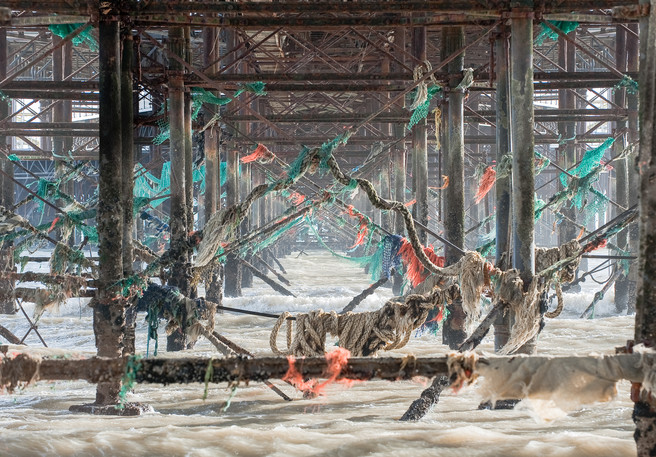
Under the pier: I was attracted initially by the light and the colours, but quickly realised this was also about pollution.
The extra ingredient
I’ve thought about this a lot and asked myself how this relates to the way I take photographs. Do I try to express feelings and emotions when I take a shot? The answer is sometimes yes, but often no. When I’m aware that I have something to express, I wouldn’t necessarily talk in terms of ‘feelings and emotions’, but there would be something about the scene I wanted to capture. For me, there are other drivers at play. The photographs I’ve used to illustrate this article have captions which describe what was in my mind when I took the shot.
I found a few interesting quotations around this subject. The first goes way back to our favourite landscape photographer, Ansel Adams.
“A great photograph is full expression of what one feels about what is being photographed in the deepest sense and is thereby a true expression of what one feels about life in its entirety.” Clearly, Ansel was very much into expressing feelings.
More recently, Gerry Badger (2010, p166) argues that:
"The real trick - and here photography becomes immensely difficult and complex - is deciding what to photograph. And that, in essence, is a two-level process. The first is deciding on the raw material - trees, nudes, war, raindrops etc – which represents a photographer finding his or her subject matter. It's an important step, but not yet ‘job done’. The second, and much more difficult step, is to say something – something unobvious and personal - about the raw material. The two are very different entities, and a photographer's subject may bear only the most oblique reference to his or her subject matter."
Here Badger isn’t asking for ‘feelings and emotions’ but is asking for some added value from the photographer, something over and above the material reality of the scene itself. Badger, having made this important distinction between stages one and two, goes on to make the damning comment that most photographers “never progress beyond stage one, except in the most trite and obvious ways.” If this is so, maybe photographers grow into expressing feelings and emotions, having mastered the technicalities of photography and sound composition. It’s a higher level of skill that not all will aspire to, achieve, or appreciate.
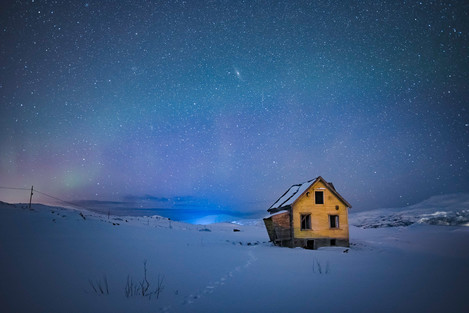
Cold and alone: My initial intent was to produce an attractive image of the hut and the aurora, but in post processing I realised the single line of footsteps in the snow and the stars in the sky created story of being cold and alone.
In another quote, Bright (2004, p8) says that what really counts when assessing whether a photograph might be considered as art is that “the work communicates intelligent ideas that are worthy of attention, appreciation and investigation”. This sounds weighty, and puts a bit more flesh on what might be “feelings and emotions”. Cotton (2004) approaches photographic art in a similar way. Her book explores the motivations and working practices of the photographic artists but from the beginning places most importance on the ideas that the photographer is wishes to communicate. This is seeking clarity on the photographer’s intent. I find the word ‘intent’ a more accessible and meaningful term. What is it the photographer is trying to do? For both Bright and Cotton, the ‘idea’ that underpins the work is the distinguishing aspect that qualifies the work as capable of being considered as art. Maybe were getting closer.
Where do motivations come from?
I think we need to take a step back and explore the motivations of the enthusiast photographer. Some might be motivated by the need to express their feelings and emotions, but for most I’d argue the motivations are more varied and complex and driven by multiple factors. I know I get as much enjoyment from the process of photography, the friendship groups, the outings, the continuous learning, as I do from producing the photograph itself.
We’re all influenced by everything around us. The images we see, the people we know, the networks we are part of. All shape our way of seeing. These are external drivers that become internalised. This being so, is there scope to be totally original? It is certainly very difficult. Must the underlying idea address the big issues in life, like Salgado or Burtynsky, or the many bits of minutia that captures our eye. I suspect the latter for most of us.
I also wonder if it is it possible for every image to have something new to say? How many new messages are there to be shared? Certainly less than the number of photographs that are produced. What happens when a photographer has a recognisable style, for example, the high contrast architectural image, or the ICM or multiple exposure, or long exposures seascapes, or any one of many more. Can each of these images produced to the same style each have something new to say, or is a point reached where the images become repetitive, technical exercises and the production of a beautiful image becomes the main motivation? And what happens when these styles are copied by others, which happens all the time, even to the point where workshops are held to teach the technique. This surely makes it a technical exercise rather than the communication of something deep and meaningful.
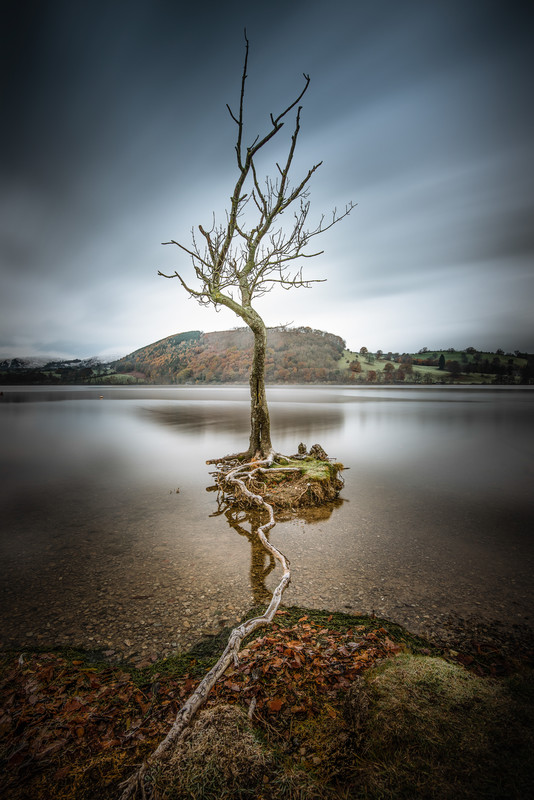
Survival: I saw this tree and the single root stretching out to the shore and immediately thought the tree was hanging on for survival.
This presents a number of challenges for the enthusiasts wanting their work to be considered as art. Evidently, it requires the enthusiast to be thinking in terms of communicating ideas as a core part of their purpose, but I’m not sure that communicating an idea is typically ingrained in the working practices of most enthusiasts. At least not explicitly. So much militates against this - the places where enthusiasts show their work, the competitions, salons, the judging and selection processes, and the focus on the single ‘impactful’ image, do not encourage the presentation of work designed to communicate core ideas. The notable exception to this is the RPS distinctions which require a Statement of Intent to support the work.
However, what does work in the enthusiast’s favour is the pictorial culture that prevails. Robert Adams, in an interview (Di Grappa, 1980, p12) puts great importance on this aspect of an image “… my feeling is that composition is the main tool we have and that a photographer has to use it. Composition is what concentrates the viewer’s attention. A bad picture doesn’t make evil seem any more evil – it just loses your audience.” In his own writings he (Adams, 1981, p27) talks eloquently about the need for beauty in photography, but makes the point that for a picture to be beautiful, “it must in some significant respect be unlike what precedes it”. Adams is arguing for sound composition as an essential starting point, the quality that enthusiast photographers have demonstrated, but in asking for the something different is also calling, like Bright and Cotton, for an underlying core idea to be present.
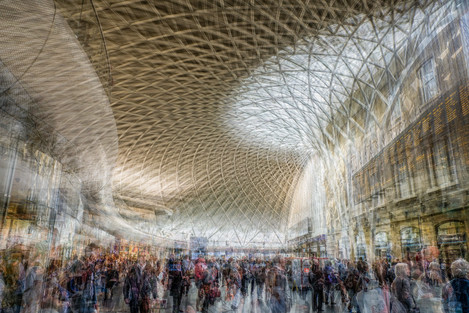
Kings Cross station: This is a multiple exposure and part of a panel of images telling the story of visitors to London rushing around all the attractions.
What about the viewer
These arguments about the images having that something extra are expressed from the point of view of the photographer. But it is relevant to ask what the viewer gets from the image and whether the viewer sees the message that the photographer seeks to convey. This again is difficult. Much has been written about the visual image being a language, and how this language is based in our culture. Semiotics, the study of signs and symbols, provides a theory for how this works (a subject worthy of study, and of a separate article). But the visual language is far more imprecise than the written word, so the viewer has a tougher job extracting meaning, and there is every likelihood that that meaning will not coincide with that intended by the photographer. This is more so for landscape images, where the ‘signs and symbols’ are far more generic than in other genres such as say portraiture, sport, wildlife. Is this why so many landscape photographs rely on beauty rather than message for their attraction?
However, the viewer can be given a helping hand to understand the photograph by the provision of a meaningful title. A factual title suggests the image is more of a record of the scene. A more abstract title can point to the real message behind the image.
So where does this leave us?
The purpose of this article has been to dig a little deeper into what that something extra is that makes a photograph. I am not questioning that this something extra exists, it clearly does, but I am asking to find a way to understand what it is in a more practical way. I don’t know that I have been successful. I seem to have asked more questions rather than provided answers.
Which brings me to my request. It would be really instructive if the authors of articles in On Landscape and elsewhere gave some insight into the ideas they were trying to express in the photographs illustrating their articles. I have tried to do this with the captions attached to my photographs in this article. But authors never usually do this. There is one exception - Raphael Rojas. Raphael has not only written several articles along these lines but has also written an eBook called ‘The Photographic Message’ which includes a second half where he presents 50 images along with the motivations behind each image. Thank you, Raphael.
If readers are prompted to comment on this article can I invite them also to attach an image plus a few words on their motivations for taking the photograph. Was it beauty or message or both? That way we might get some practical insight into what it is that photographers are trying to achieve.
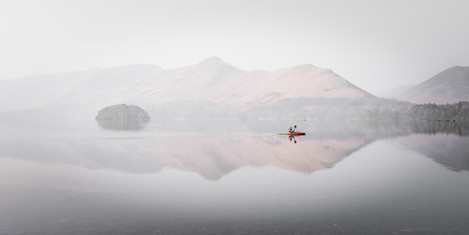
Tranquillity. The intention was to produce an attractive image capturing the tranquillity of the lake.
References
- Adams, R (1981), Beauty in Photography, Essays on defence of traditional values, Aperture
- Badger, G (2010) The Pleasures of Good Photographs, Aperture
- Bright, D (2011) Art Photography Now, Thames and Hudson
- Cotton, C, (2004), The Photograph as Contemporary Art, Thames and Hudson
- Di Grappa, Carol (Ed), (1980) Landscape: Theory, Interview with Robert Adam, Lustram Press
- Generations: This is about ageing and is both sad and hopeful at the same time.
- Under the pier: I was attracted initially by the light and the colours, but quickly realised this was also about pollution.
- Pier and boat: This is entirely about producing an attractive image.
- Cold and alone: My initial intent was to produce an attractive image of the hut and the aurora, but in post processing I realised the single line of footsteps in the snow and the stars in the sky created story of being cold and alone.
- Survival: I saw this tree and the single root stretching out to the shore and immediately thought the tree was hanging on for survival.
- Kings Cross station: This is a multiple exposure and part of a panel of images telling the story of visitors to London rushing around all the attractions.
- Stairs: This is a design shot intended solely to produce a beautiful image.
- Tranquillity. The intention was to produce an attractive image capturing the tranquillity of the lake.
- Clevedon Pier. The intention was to produce an attractive image using long exposure

